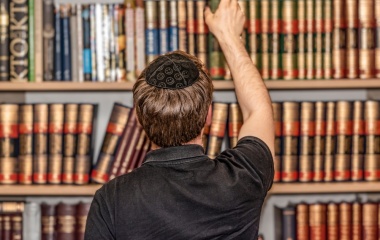
The years following the destruction of the Temple were fraught with great danger and uncertainty. The infighting that had so weakened the Jewish people threatened to completely tear them apart. Hundreds of thousands were killed or exiled, with the many sects that could not make the transition from a Temple-based Judaism disappearing. The houses of Hillel and Shammai argued so vehemently that there was fear they would “make the Torah into two Torot” (Sanhedrin 88b). With the Sanhedrin no longer in Jerusalem, its authority was questioned. Debates arose as to how to best remember the destruction, with some going so far as to advocate that Jews stop having children, i.e. that we self-destruct (Bava Batra 60b).
As the centre of Jewish life shifted to Yavne—Jerusalem was off limits to Jews—Rabban Gamliel was appointed the Nassi, leader of the Jewish people. Descended from Hillel, he was the right leader at the right time. He fully understood that bringing unity from the chaos of Jewish practice was the call of the day. It was under his leadership that the law was established in accordance with Beit Hillel, and the determination that “the [teachings of] Beit Shammai in relation to Beit Hillel are not [valid]” (Brachot 36b).
When one considers that many of the personal family practices of Rabban Gamliel were in accordance with the teachings of Shammai, this was no small matter. But he understood that the dichotomy in practice could go on no longer, and it was the rulings of the House of Hillel that were best for the nation. While debate and dissent continued unabated, Rabban Gamliel was zealous in his efforts to prevent schism. It is for this reason that he insisted Rabbi Yehoshua violate the day he had calculated as Yom Kippur. If there were going to be two calendars, there would inevitably be two peoples (Mishna Rosh Hashanah 2:9).
But, as is inevitable, these strong and necessary tactics had horrible side effects[1]—especially as little effort had been made to implement them in a less confrontational way. The tragic story of the excommunication of Rabban Gamliel’s brother-in-law, Rabbi Eliezer the Great, rocked the Jewish world and even led to Rabban Gamliel’s own death (see here). But such was the price he felt had to be paid at this historic juncture.
Debate and dissent was encouraged, provided one accepted the ultimate authority of Nassi. His humiliation of Rabbi Yehoshua was meant to drive that point home. Of course, one can go too far, risking religious totalitarianism and the alienation that is bound to follow. And Rabban Gamliel operated very close to the unknowable line separating strong, effective leadership from dictatorial leadership. It was the apparent crossing of this line—for the third time—that led to his removal from office.
The story is relatively well known (see Brachot 27b-28a) yet as is often the case, we tend to gloss over some of the details. The contours of the story are as follows: It all began when an unnamed student asked Rabbi Yehoshua if ma’ariv is an optional or obligatory prayer. Rabbi Yehoshua responded that it was optional. This student—likely in violation of Jewish law[2]—then asked Rabban Gamliel the same question. When Rabban Gamliel told him that it was obligatory, the student said, ‘But Rabbi Yehoshua said it was only optional!’. Rabban Gamliel told him to wait until all arrived at the Beit Midrash, at which point the student, presumably instructed to do so by Rabban Gamliel, asked the same question of all assembled. Rabban Gamliel answered that it was obligatory, and then asked if anyone disagreed. Rabbi Yehoshua, feeling it was inappropriate to publicly disagree with the Nassi, and unaware of what Rabban Gamliel already knew, answered in the negative. Silence would have been golden.
Instead of moving on with his shiur and privately thanking Rabbi Yehoshua later, Rabban Gamliel decided that this was the time to again show who was boss. “He said to him: ‘Yehoshua, stand on your feet and they will testify against you’” that you are lying. Rabbi Yehoshua had little choice but to acknowledge his view. Point made—but this, too, was not enough for Rabban Gamliel. Reminiscent of years gone by, when misbehaving students were forced to stand in a corner, Rabban Gamliel, sitting, continued on with his shiur, as Rabbi Yehoshua remained “standing on his feet”. This was more than the people could take, this being the third time Rabban Gamliel had publically humiliated Rabbi Yehoshua. They forced the shiur to end right then and there, and decided it was time to replace Rabban Gamliel.
In his stead, Rabbi Elazar ben Azaria was appointed, and major changes lay ahead. Rabban Gamliel allowed entry only to those “whose insides were like their outsides”, those of unquestioned piety, going so far as to appoint a guard at the entrance to the Beit Midrash to prevent “undesirables” from entry.
Clearly, this policy worked all too well. The first act of Rabbi Elazar ben Azaria was to remove the guard, opening up the Beit Midrash to all. So many wanted to learn that they had to bring in 400—and some say 700—extra benches to accommodate all. With so many voices added to the symphony of Torah, “there was no matter that was left hanging in the Beit Midrash”.
Yet despite being publically reprimanded both on a personal and professional level, “Rabban Gamliel did not remove himself from the Beit Midrash for even one moment”. What an unbelievable act of humility, kindness and repentance! Imagine a shul rabbi, unceremoniously fired in the middle of a derasha one Shabbat morning, coming to the shiurim of his successor, every single day. This one act itself goes a long way to demonstrate that Rabban Gamliel’s actions throughout were done only to ensure the unity of the people. He may have been too high-handed, but these were mistakes “for the sake of heaven”.
Yet acting for the sake of heaven is never enough; one must ultimately do what is right. And Rabban Gamliel still had more to learn.
On that very day, the Talmud relates, “Yehuda, an Amonite convert” came to the Beit Midrash asking if he could join the community of Israel. Rabban Gamliel, quoting the verse, “an Ammonite and Moabite shall not enter the community of Israel”, said absolutely not. His exclusionist philosophy extended beyond the circle of the Beit Midrash. Yet Rabbi Yehoshua noted that, since Sancheriv had “mixed all the nations”, we can no longer definitively identify the origins of any particular person; we can accept Yehuda relying on the fact that most people are not from Amon and Moav. When Rabban Gamliel saw that he was accepted, he said, “Since it is such, I will go and appease Rabbi Yehoshua”. While he could have done so with a perfunctory (or even not perfunctory) “I’m sorry” in the Beit Midrash the next day, Rabban Gamliel made a special visit to his home in order to apologize.
Rabban Gamliel, noticing the black soot on the walls, remarked that, “from the walls of your house, I can tell that you are a blacksmith”. Rabbi Yehoshua was not impressed. “Woe unto the generation that you are its leader, for you do not know the difficulties of Torah scholars, how they make a living and how they feed themselves”, he responded. Sadly and tragically, Rabban Gamliel was out of touch with the average Jew. And perhaps that is why Rabbi Yehoshua ignored Rabban Gamliel’s request to forgive him. However, when he asked to be forgiven “for the honour of his father”, a kind of zechut avot, Rabbi Yehoshua agreed. Like it or not, coming from the right family can go a long way.
The rabbis were now in a quandary. With Rabbi Yehoshua’s forgiveness of Rabban Gamliel, and with Rabban Gamliel wiser and more sensitive, it was felt that he should be re-appointed. But what was to be done with Rabbi Elazar ben Azaria? The idea of having rotating weeks where each would speak every other Shabbat was deemed unworkable, as it would lead to jealousy amongst the co-leaders[3]. It was thus decided to have Rabban Gamliel give the derasha three out of every four weeks, with Rabbi Elazar ben Azaria speaking the fourth week. In other words, Rabban Gamliel did not get his full job back, teaching him that his actions could not go unpunished, and Rabbi Elazar ben Azaria was not seen as merely an interim leader.
I recall hearing in the name of Rav Soloveitchik that, by insisting on a dual leadership model, our Sages were hinting that both the educational approaches of Rabban Gamliel and Rabbi Elazar ben Azaria are necessary. All have a G-d-given right to Jewish education, and we need to welcome and embrace all who want to learn. At the same time, we need elite institutions that accept only the best and the brightest. To achieve greatness, one must be surrounded by greatness. It is for good reason that Harvard does not accept all who apply, and for the same reason, neither did the great yeshivot of the 19th century.
[1] I am reminded of Rav Yaakov Emden’s efforts to rid the Jewish world of Sabbateanism. He was quite successful, but in the process, many innocents suffered greatly.
[2] Asking the same questions of a second rabbi without informing him that another has already decreed an answer demonstrates a lack of respect, and is generally prohibited. It is harder to get a verdict overturned on appeal than to be declared innocent in the first place.
[3] I love the honesty and humanity of the rabbis. I imagine no one reading this would be surprised to hear that rabbis can be jealous of one another. But it is refreshing to hear our greatest rabbis acknowledge this reality. It is this reality that made the partnership between Rav Amital and Rav Lichtenstein at Yeshivat Har Etzion so beautiful and so unique.



